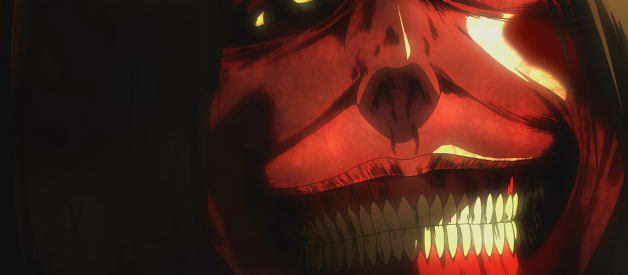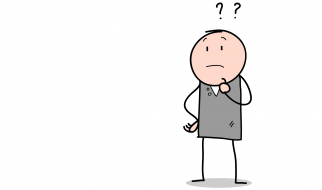ATTENTION: Content warning for descriptions of blood, gore, and human experimentation. Also, this article will feature massive spoilers until up about chapter 90 of the manga. You?ve been warned! Also, yes, you can use this article to tell people Attack on Titan is a fascist show.
This article is a collaboration between Ruben Ferdinand and Elli?t!
The very first one-and-a-half minutes I watched Attack on Titan, I was filled with a sense of glory. Like I could do anything. The music, the animation, the contrast between brutal imagery and intense combat, I was on the edge of my seat for an opening. And afterwards, I felt like going for a 5-mile run. Five years later, now I know how to write good thinkpieces, I?d like to know why and how it made me feel that way. (I?ve since then put on the soundtrack everytime I go for a jog, which, let me tell you, works very well.)
Attack on Titan is a fantasy-horror story with pseudo-zombie enemies called Titans. It takes place in a hodgepodge pastoral Germany where angry teens with names like Connie get drafted into the military and are trained as Spidermen With Swords. What remains of humanity lives under an authoritarian-monarchist state, isolated and protected from the outside world by three massive concentric walls. Dressed in snappy uniforms stamped with striking emblems, the teens utilise the toll-taking ?3D maneuverability gear? to get the upper hand on Titans. The first thing that happens in the series is Titans breaching through the walls, a hundred years of peace at its end. The world quickly becomes dark, gorey, and traumatic. Death by cannibalisation is a constant, ever-present threat, even when the Spiderteens start to take the fight to the Titans. Watching the mindless monstrosities rip into innocent townsfolk, then the proud nationalist troops rip into monsters, it?s hard not to feel a type of way: excited, repulsed, powerful? It?s a way of being affected.
Affect can be described as the feeling immediately after seeing or hearing something not under your control, an emotional reflex of sorts. Affect is not arbitrary and uncontrollable, though? it can be directed and utilised for a specific purpose in conjunction with story, narrative, and, most importantly, aesthetics. Attack on Titan affects its audience not only with its visceral sequences of blood and blades, but with the cusp-of-war European imagery it consistently applies to its characters and locations. With paced-out dialogues, overdetailed facial close-ups, and sudden violent escalations, Titan conveys a constant sense of dread, capturing it within a historically and allegorical context. Series mangaka Hajime Isayama draws from an imagined past, but a past nonetheless, and Elliot and I believe that these aesthetics ? those of horror and those of militarism ? are the key parts to figuring out: how does this series instrumentalise this ?affect? and to what end does it do that?
Titans: the affect of horror, the propaganda within dehumanisation, and nationalism.
Most, if not all modern zombie narratives start with an ?outbreak event? (the irrupting pandemic and subsequent apocalypse) that are about 1) containing the threat, and 2) surviving after the first step fails. Titan flips the script from the start: humanity is the contained faction, pitted against a horde of seemingly endless, endlessly tall and nude cannibals that were already there. This ?walling in? part is important, because it lends credence to a central metaphor. Namely, that humanity is under siege. The city is home to all that?s left of humanity, making its besiegers attacking all of humanity. Concurrently, those attacking humanity are automatically branded as belligerent and inhuman: you tend to side with the people trapped in the cage, not those out of it. We can ideologically frame these dehumanised monsters as ?enemies of mankind? without feeling too bad about their expiration or being too concerned with their motivations. Also, I mean, look at them.
 Doing a visual analysis of these things is the worst thing I?ve done to myself.
Doing a visual analysis of these things is the worst thing I?ve done to myself.
Part of what makes the terror of Titans so effective is their bodies. For one, they differ heavily in size. Ranging between ?3-meter classes? and ?50-meter classes?, they easily tower over the average person. But it?s not just the fact that they?re giant ? it?s that they look like Really Weird People. Their distorted proportions and elongated limbs only vaguely adhere to the human body plan, but they still resemble a human phenotype: hairy or bald, thin or big, happy or sad. Throughout the manga?s nearly decade-long run, you?ll seldom find two Titans that look anatomically identical. Their mannerisms underline this, too: during the Female Titan arc, the Survey Corps (Scouting Legion if you?re nasty) encounters many ?aberrant? Titans that don?t follow the normal behavioural conventions of zombies. These aberrants run, move on four legs, or stand completely still unless annoyed. All of this suggests a wide variformity in Titan physiology and behaviour, making them more monstrous through their uncanny yet unpredictable resemblance to humanity.
As mentioned, creatures in horror operate on a set of rules. Ghosts take possession of people but can be exorcised; zombies eat people but are slow, etc. These are discernible guidelines that expose a monster?s vulnerable points and/or their origins, providing a solution. Most monster horror stories clarify where the monster comes from, because it lets the main cast figure out its weaknesses. Titan makes its monsters scary not just through visual design and visceral display, but by delaying this learning process. The rules for killing Titans can?t adequately inform a combat strategy other than ?try to kill them, I guess?? In general, Titans can only be killed if you cut out their nape. This puts the military at an enormous disadvantage, seeing as Titans are simply too tall to reach normally and slicing requires a lot of strength and momentum. So although their principal weakness is known, it?s still extremely difficult and dangerous and in many cases lethal to act on it.
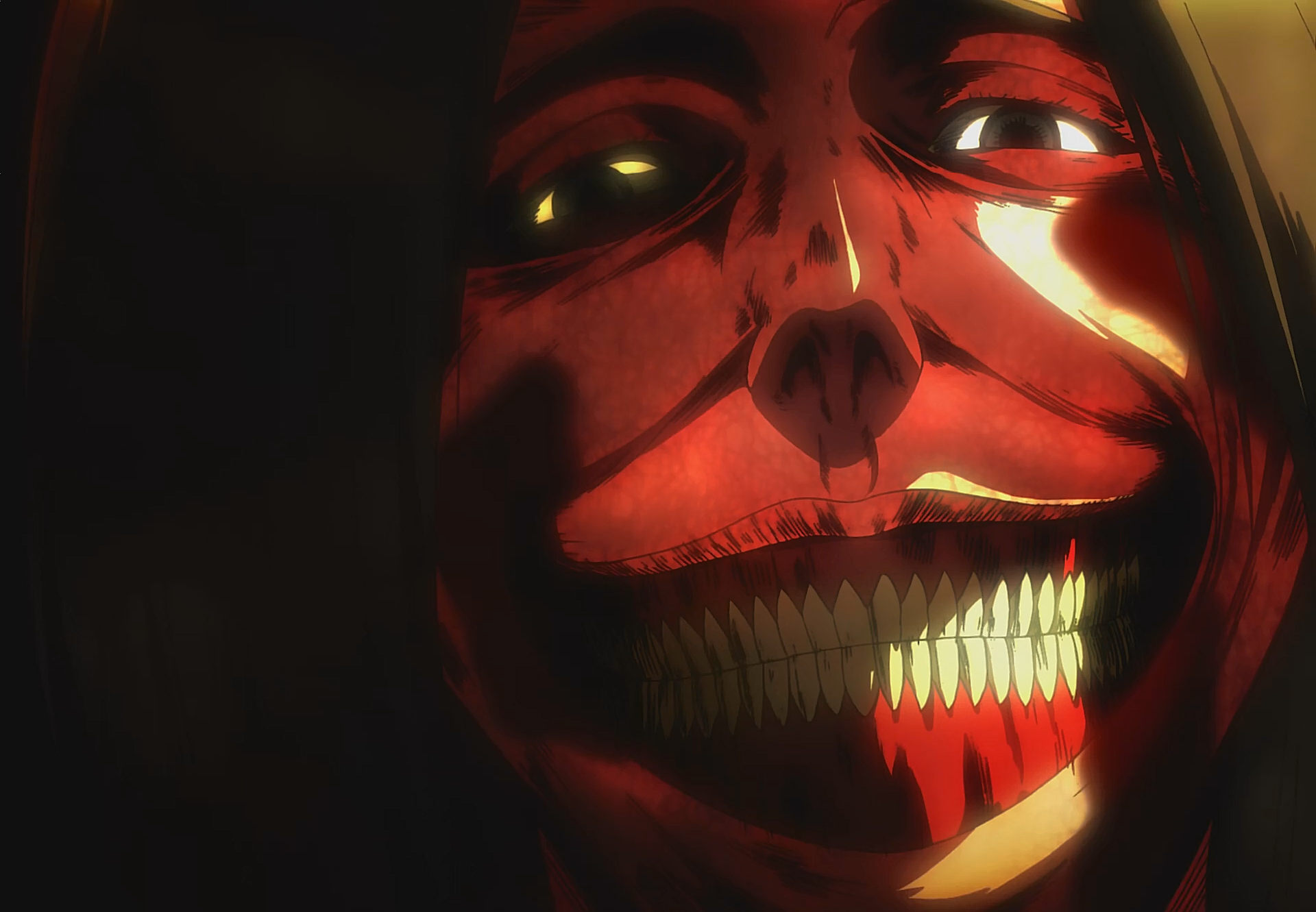 The ?Smiling Titan?
The ?Smiling Titan?
In taking on the Titans, technology plays a huge part. They can?t be shot or destroyed through conventional means ? cannons and most exposives are woefully ineffective ? , so only with the 3D maneuver gear do our Spiderteens stand a chance. Hookshots, gas cannisters, and giant box cutter swords look wildly out-of-place, even sci-fi compared to the historical muskets and the simple artillery the rest of the army uses. The 3D maneuver gear symbolises superior technology that stands out in efficiency and design.
Given Titan?s aestheticisation of history, it?s not a stretch to compare it to Prussia at the turn of the 19th century. Prussia prioritised mobility and shock tactics over numbers and raw manpower. Even so, the maneuver gear is extremely experimental and bears a high and unforgiving skill ceiling (mortality rates for recruits are very high). Moreover, the mobility doesn?t guarantee success. Even though the Spiderteens are fast and agile, it only takes one Titan to raise its arm and grab the wires, or place a well-timed chomp for a painful death to lay ahead.
Knowing their weakness doesn?t solve the bigger problem of infinite huge cannibals, however. The only thing that?s known about Titans is obtained from what they?ve already been doing to humanity: they eat. But, again, why? This most common and frightening aspect of the series? visual language is never accurately addressed. What?s mentioned at one point, however, is that Titans don?t have to eat to survive. For some reason, they only need sunlight to energise, which bizarrely puts them in the same taxonomy as plants. Titans, then, don?t gore and vore people for nourishment, and their fully-functioning digestive tract (Eren spends some time in a Titan stomach) is apparently entirely rudimentary.
There?s a scene in the Female Titan arc where a couple of characters discuss this. When they arrive at this hypothesis, they freeze up. None of them say it out loud, they look disturbed by the thought, but the suggestion permeates the room that, maybe, Titans eat for entertainment? Suddenly, the Titans make a bit more horrible sense: their baby-like proportions, their awkward, almost playful body language, their puerile attitudes and vacant smiles? The characters may know, but they never say it: here, the learning process gets outsourced to the audience in an intrusive way. Attack on Titan instrumentalises the power of suggestion, leaving just enough room audience-side for an affective terror.
Affect is ultimately rooted in what we can?t compartmentalise. We can know we?re scared, but not knowing why we?re scared is even scarier. Establishing and exposing these monsters as truly mindless, violent, and abhorrent gives the narrative an impenetrable excuse: the extermination of Titans is indubitably a good thing. This is reified in Eren?s endearing character trait: yelling in a shrill voice ?I?ll kill them all? before getting owned super hard. Titans embody no political message, nor do they hold any agency; they are a canvas on which a faceless antagonism can be smeared and heroic sacrifice can be made. It?s not about the zombie menace, it never has been, it?s about humanity?s reaction to it. It is a narrative device that is both the cause and the excuse for nationalism (or worse). This brings us to more problematic parts of Attack on Titan?s aesthetics: its military.

Military: the brutalisation of necessity, the instrumentalisation of glory, and also still nationalism.
Situating Attack on Titan?s military politics is hot potatoes given the series? publishing history. In 2010, series mangaka Isayama Hajime admitted to have modelled military commander Dot Pixis after Imperial Japanese general Yoshifuru Akiyama, who led the Japanese occupation of Korea until 1930 and was directly responsible for numerous bloody suppressions and countless civilian deaths. Then in 2013, the South Korean newspaper Electronic Times wrote an article accusing the series of having a militaristic message that supports Shinzo Abe?s controversial political stance of revisioning Article 9, the anti-war clause. Later that year, a blogpost appeared which detailed some Twitter beef, in which Isayama allegedly downplays the brutal atrocities the Imperial Japanese army committed during its occupation of Korea. The same year, following the release of the anime, countless articles popped up pointing out nationalist, militarist, and propagandistic imagery. These critiques (though in the third and other cases, ideological commendations) comment on the series? convincing authoritarian aesthetic.
This seems to slot the series into a wider, ultranationalist trend in Japanese pop media: Strike Witches (2008), Girls und Panzer (2012), and Kabaneri of the Iron Fortress (2016) to name a few. All invoke the aesthetics of powerful Imperial Japanese war machines, while conspicuously dodging all of the historical context and political connotations of utilising such assets in favour of cute, affable characters fighting for Japan (or a heavily implied Japan-analog). Among the most popular is the free-to-play game and massive media franchise Kantai Collection (2013), which anthropomorphises ships of the Imperial Japanese navy as cute and affectionate girls who go to war for you in a play-friendly Pacific Theatre. It?s also developed revisionist history, depicting the Japanese as victorious in the decisive Battle of Midway.
It can?t be denied that in Titan, there is an aesthetic and narrative emphasis on the glory of military, the necessity of sacrifice for the greater good, and terror and death at the hands (and teeth) of an enemy horde. Humanity under threat isn?t a new concept, and the premise of Attack on Titan is no exception. Through the Titans, the series introduces an absolute morality that constructs its military forces as a literal ?army for humanity?, making all its actions seem tragic and cataclysmic, but ultimately justified against the onslaught of monsters. The plot pivots around an us-vs-them duality, and when there is no coherent identity to ?them?, it?s crucial to look at ?us?. Titan?s uses a historical allegory, but what type of history does it mean to show to us? What things are highlighted, what is given weight, what is omitted? The image of this distilled society tells us many things about an author?s own ideas about what mankind is, who gets to be a part of humanity, and how it should be.
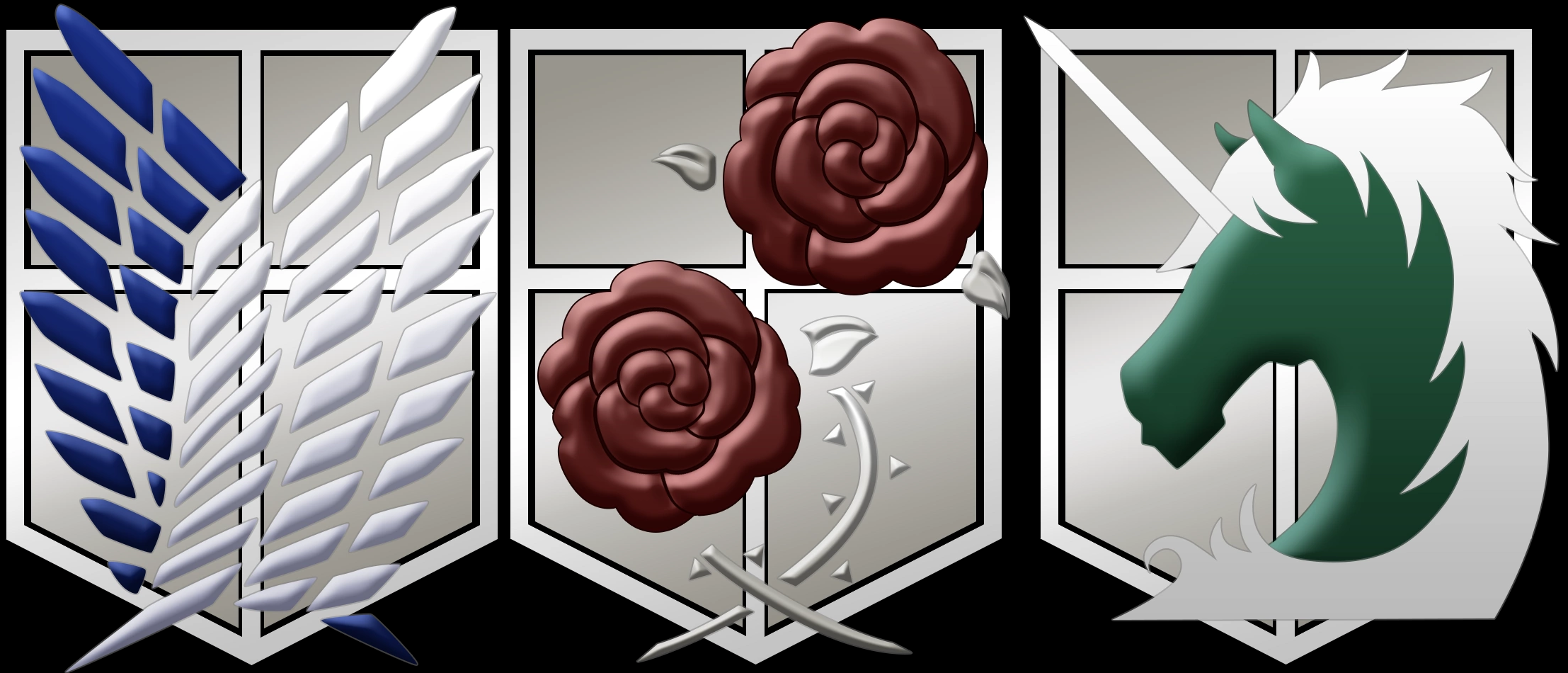 The insignias of the three main factions: The Survey Corps, the Garrison, the Military Police
The insignias of the three main factions: The Survey Corps, the Garrison, the Military Police
One way Titan differs from conventional zombie media is that instead of following lone gangs of survivors navigating the zombie apocalypse, a standing army is in place to fight and protect this nebulous definition of humanity. Concretely, the military consists of three factions: ?Military Police?, ?Garrison?, and ?Survey Corps? ? all militarised terminology. Indeed, there is no categorical difference between army or police, making order and peacekeeping an inward military operation. Enlisting as a recruit is possible from age 15, and it?s telling that most of Titan?s cast is teens. It follows shounen character rules of making ?children are the future? literal, but this ends up focalising a battalion of child soldiers. The Military Police protects the innermost walls, where the rich and royals reside (only the top 10 best recruits may join the bourgeoisie defence force). The Garrison is responsible for patrolling the top of the Walls and city streets. The Survey Corps is the faction that goes beyond the walls to scope out the situation, secure outposts, and learn more about the Titans. It?s stated outright that the Survey Corps is the ?least corrupt? of the three, as their mission concerns Titans, not people. It also doesn?t answer directly to the monarchist government, which is an interesting measure for corruption.
 Eren gets owned (first of many)
Eren gets owned (first of many)
Clearly, the military is presented as the only faction that is organised and weaponised enough to save humanity. A military needs an enemy, after all, and when the enemy wants to exterminate humanity, guarantying its existence is a must.
We have drawn a conclusion from the gravitas of fighting the Titans (as a means to save humanity) and the only available resources of doing so (the risky 3D maneuver gear): to fight means to be ready to sacrifice yourself. This often translates to dying horribly, and Titan pulls no punches getting that point across. Take our hero Eren on his first day. Blustering he?ll kill them all, Eren flies off into battle, and it only takes 12 seconds for the above to happen. He then gets swallowed by a big old dude. Determination and conviction have no optics to them: getting eaten alive looks the same to anyone. It?s painful, horrific, and demoralising. Titan has the tendency (Titans have the tendency?) to undermine moments of action and nationalistic glory with a sudden, disruptive death. An intrusive reminder that, actually, war is bad.
Despite the focus on military action and strategy, there are many times that the series moves the lens to civilian life ? daily life, commerce, life under military rule, these scenes give us a glimpse of the meticulous ways of how the government exerts its control. Given the wall setting, freedom of movement is physically constricted for most citizens. The monarchy has an absolute say over its populations, placement and census-wise, and it utilises this divine right often. The first example of this happens at the start of the series. After the fall of Wall Maria, all of the survivors flee into the inner (smaller) walls. Two weeks later, 250,000 civilians are forcibly conscripted into some sort of ?liberation army? and are sent into the lost territories, now teeming with Titans. To no one?s surprise, everyone dies. This, as revealed in The Uprising arc, was to ?manage? the population crisis. In other words, a planned genocide of refugees. A suicide mission of that scale wouldn?t succeed if 1) the military hadn?t cooperated, and 2) if the conscripts believed they didn?t stand a chance. Soldier morale tends to be contingent on the monstrosity of the enemy, constructed through propaganda or otherwise. It had to have been high, at least until the gates close.
With all its naked brutality, though, this event doesn?t read as if it tries to convey a sense of honour of glory. It feels more like a brutalisation of necessity: what actions an autocratic government will resort to under duress. A humanitarian crisis is turned into a controlled genocide, under the guise of patriotic mobilisation. Multiple characters expound quite bluntly on the propagandistic conditions and the emotional results of the event. People were lied to, many lost their lives, and many more lost their family. We get a sense that the walls seem more like a prison with a warden.
Many battles later, in the Return to Shiganshina arc, Survey Corps commander Erwin Smith gives his troops a dour speech before a decisive charge, somewhere along the lines of: ?you will die, and your deaths will be in vain. But you must die for this one plan to maybe work.? He tells them to sacrifice their hearts (?shinzou wo sasageyo?, a lyric repeated in the show?s opening credits). Soldiers fall to despair, knowing they won?t survive even if they turn tail and run. In the end, they do it anyway, charging headlong at an indomitable foe that literally shreds them apart. It?s a gruesome, gloomy scene, the futility of this banzai charge apparent in every line of ink. Titan employs its militarised aesthetics to depict war as something traumatic, bloody, inglorious, and even downright hypocritical.
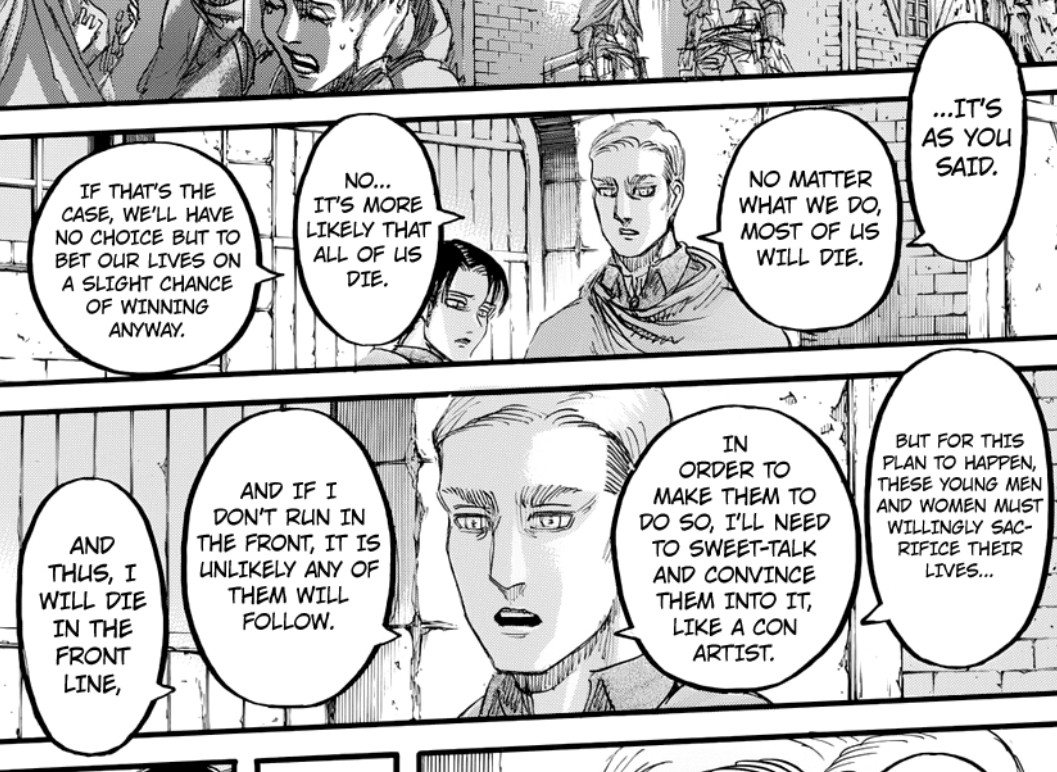 Read right to left: Erwin reflecting on his speech.
Read right to left: Erwin reflecting on his speech.
Merely showing war is insufficient, however. The series seems at odds with itself as it alternates between showing death-as-excess and death-as-glory. This does not necessarily constitute as a pro-war statement; subversion is achieved by employing familiar aesthetics and tropes and making them interfere with the standard formula. But, Titan doesn?t succeed at subversion, especially not how it equates ?casualties? with ?sacrifices?, i.e., ?acceptable, unavoidable losses?. If anything, Titan emphasises that (self-)sacrifice is a requirement for victory. If mountains of corpses are required to succeed and to emerge victorious over an enemy who will stop at nothing to eradicate you, is that then not something you just have to begrudgingly accept?
In this, ?the horror of war? is shackled to ?success?. Again and again, self-sacrifice is the fatalistic stratagem that allows the ?bigger plan? to succeed. Dying for the ?greater good? ? the nation ? is a trope instantiated as a military goal: everything is permitted for the imperative defeat of ?the enemy? (because the enemy?s defeat is the same thing as our victory?right?). Titan does nothing but glamourise the fallen. No truly valuable comment on the brutality of war can be made when there is no alternative being presented, or even possible within the capacity of its narrative. Because in the end, it is presented as the only vehicle forward.
As a result, Titan succeeds in showcasing the bloody reality of war, the tragedy of soldiers as mere pawns, and the stakes of what it means to lose. However, the very conditions that allows humanity to fight the Titans at all ? from the 3D maneuver gear to the militarised society ? rely on a readiness to die for the cause.
Conclusion
Attack on Titan masterfully communicates its desired affect by emotionally involving audiences in a constant cycle of effort and hopelessness. Yet under this veneer of fear and futility, there is a pro-war narrative that exhibits soldiers as (self-)righteous, honourable, and ?the only ones doing anything about this mess?. Considering Japan?s history with military conquest and Attack on Titan?s echoing of early 20th century Germany, the premise of a nation militarising to defend itself ends up a ultranationalist one, one that keeps snowballing itself.
Nationalism in a Japanese context is dicey. To be proud of a nation means to be proud of what it has done. In some ways, this is possible: the prevalence of historical Japanese media that take place in the Sengoku period are an excursion to Japanese history and pride without an explicit expansionist, fascist, and imperialist belligerent context. Samurai Champloo, for instance, celebrates diversity and culture clash, not cultural hegemony under a strict border. It?s important to remember that a certain historical nostalgia, imagined or otherwise, always belongs to a certain class of people. It behooves to ask, whose?
Transposing that pride, however, to the Meiji, Taisho, and Sh?wa periods means tacit approval of the Empire of Japan as a military might and a political power in its imperialist, fascist shape. Historical saudade goes hand-in-hand with revisionism, historiographical erasure, and the outright denial of war crimes. Even now, the Abe government refuses to reconcile with the affected countries on the sexual enslavement of hundreds of thousands of women during the Second Sino-Japanese and the Second World War. The aesthetics of Titan may not be Japanese or oriental, but its politics offer a special, verifiable blend of Japanese nationalism and total war.
Fascist ideology places the nation before the individual by formulating the nation as being under constant, outside threat. The only way to deal with this threat is to exterminate it. The threat, of course, is always inhuman and vulgar. Subjects so deeply obscene, doing all things that are morally repugnant, they become impossible to empathise with. This becomes an excuse for policies of never-ending invasions and territorial conquest ? any military action gets the rhetorical justification that it ensures the nation?s safety, because it promises that the nation will go on. Convenient.
As a result, the army becomes the principal institution. Conversely, the individual fighting for their country becomes the most important member. Extrapolating on that, a soldier?s willingness to die for their country ? to fight without personal concern or gain ? is the greatest glory that is can be achieved. When all of society is militarised, even civilians (?non-soldiers?) are drafted. They become part of that which is under siege, ergo, they are a military subject. This way, even civilian deaths are something that can be romanticised and glorified, as they will have died ?for the nation?. Glory as seen as a military affect ? an intense gratification only achievable through contexts of war ? is an instrumentalisation of emotion, something that directly benefits military complexes and fascist-totalitarian states.
Through the very invention of the horrific Titans and the exclusively-military option of fighting them, Hajime Isayama has placed the emotional and emotive emphasis on a dubious foundation. Its violent images invoke a sense of dread that leads to sympathy and frustration, the ones you could rally behind because your gut tells you what you?re seeing isn?t just. Characters give up everything to ensure that humanity, imagined as a single nation, survives the onslaught. Put differently, everything about the series justifies and promotes war as a means to preservation.
That trope is mined from the bedrock of Japanese ultranationalism. Apologists for the Japanese empire have this pablum: ?the only way that Japan could have resisted Western imperialism was by becoming an empire itself. Everything we did was to fend off a looming threat.?
Sounds familiar, doesn?t it?
Indeed, historical revisionism is an attempt to release historical facts from the display box. Yet, its attempt is not to speak what has been unspeakable. Its aim is to remove these facts from the display box altogether, leading to yet another ?assassination? of our memory.
? Ingyu Oh, in: FORGIVING THE CULPRITS: JAPANESE HISTORICAL REVISIONISM IN A POST-COLD WAR CONTEXT
